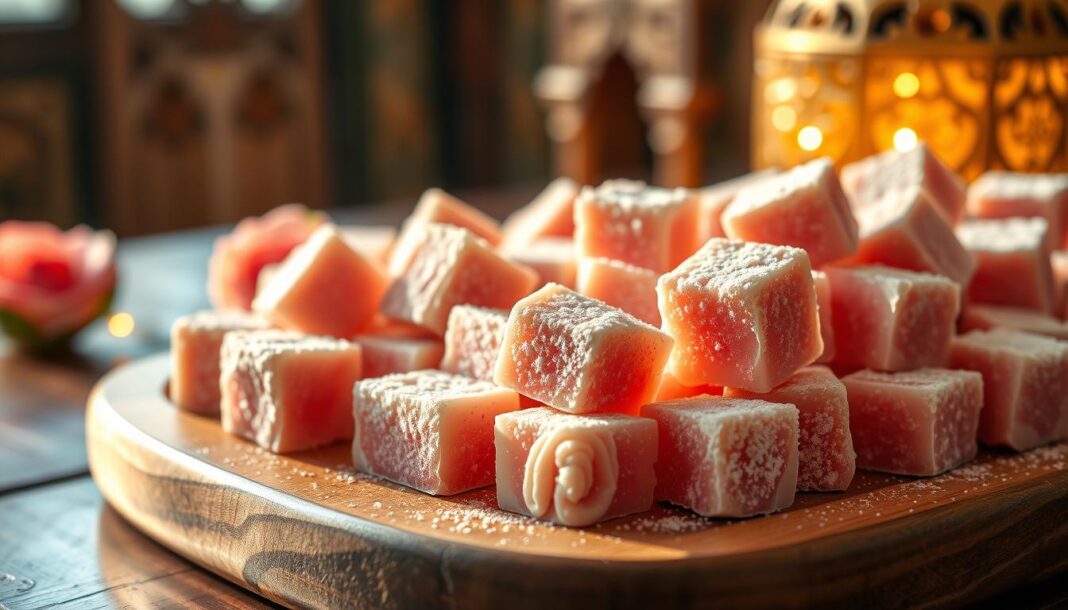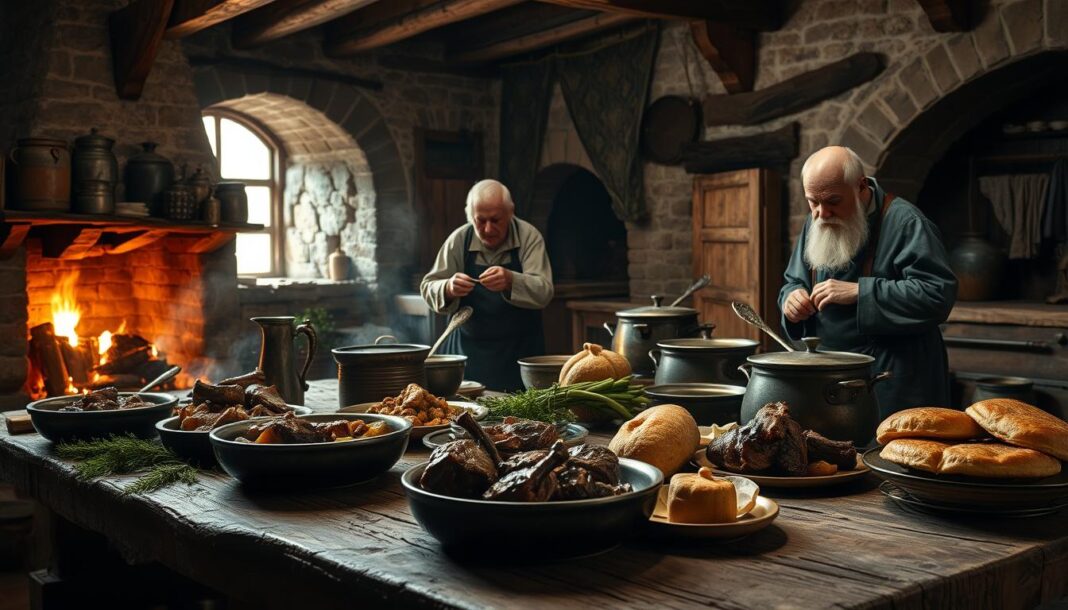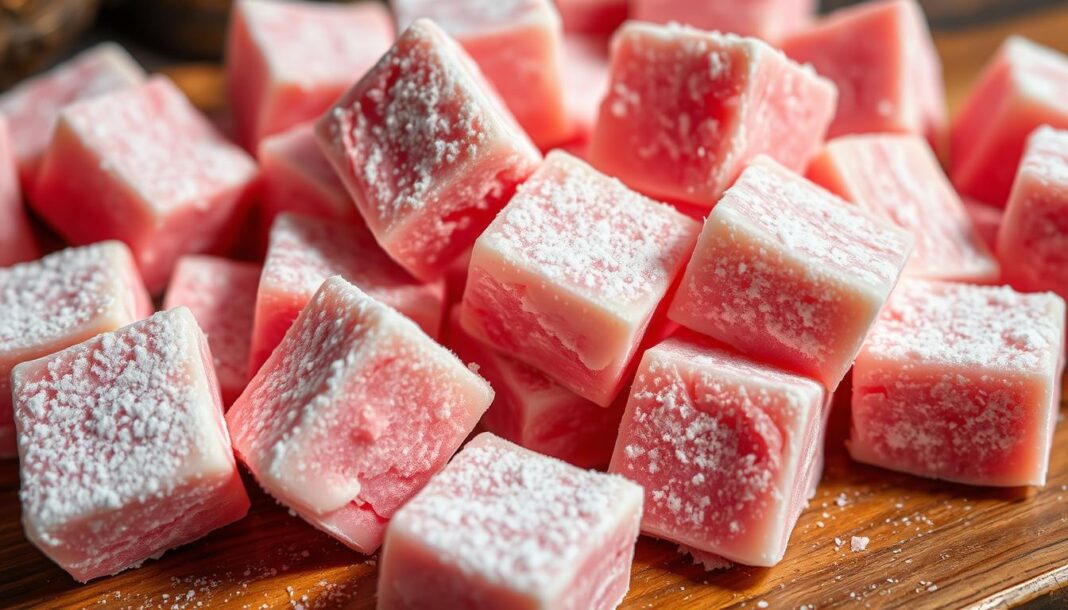We explore the fascinating history behind the iconic Turkish Delight featured in C.S. Lewis’s “The Lion, the Witch and the Wardrobe.” This sweet treat has become one of literature’s most memorable food moments, captivating readers and viewers alike.
The White Witch uses Turkish Delight as a tool of temptation in the narrative, representing false promises and luxury in a barren world. Historically, Turkish Delight was a royal favorite in Ottoman courts, symbolizing hospitality and diplomacy. To learn more about the history and significance of Turkish Delight in Narnia, we delve into its cultural and literary context.
Key Takeaways
- The significance of Turkish Delight in “The Lion, the Witch and the Wardrobe” as a tool of temptation.
- The historical context of Turkish Delight during wartime Britain.
- The cultural history of Turkish Delight dating back to the Ottoman Empire.
- The representation of false promises and luxury in the narrative.
- The traditional recipes and ingredients used in Turkish Delight.
The Magical Allure of Turkish Delight
The enchanting world of Turkish Delight, also known as lokum, is a realm where traditional confectionery meets magical allure. We explore this sweet treat’s unique characteristics and rich history.
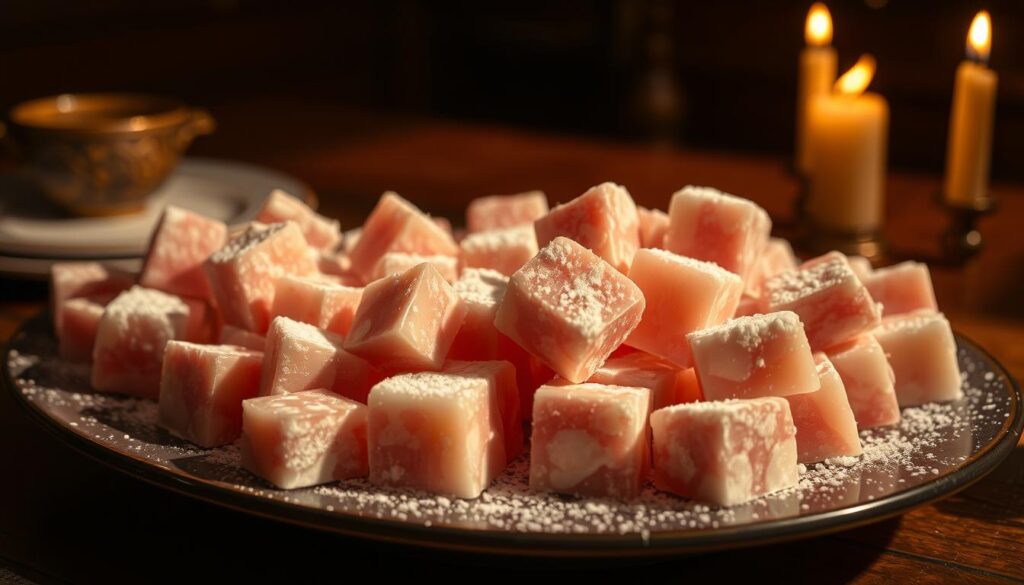
What is Turkish Delight?
Turkish Delight is a gel-based confectionery made by heating sugar and starch, creating a unique texture that falls between gumdrops and Jell-O. This distinctive mouthfeel is a result of the balance between sugar and starch, which mellows out the sweetness and allows the flavor to shine through. Traditionally flavored with rosewater, Turkish Delight offers a characteristic floral note, though many variations exist with different flavor profiles.
- A gel-based confection with a unique texture.
- The balance of sugar and starch creates its distinctive mouthfeel.
- Rosewater is the traditional flavoring, though many variations exist.
Origins in Turkey: Lokum’s Rich History
Lokum has been a part of Turkish culture since the 18th century, giving candymakers ample time to perfect their recipes. Originating in Turkey, this sweet treat was considered an exotic luxury in Britain during the early 20th century, making it a perfect enchanted treat for C.S. Lewis to feature in his works. Understanding the authentic origins of this candy helps explain its irresistible allure, as seen in its portrayal in literature.
The rich cultural history of lokum in Turkey contrasts with its commercialization and sometimes misrepresentation in Western markets, highlighting the importance of understanding its traditional food culture.
Candy from Narnia: Edmund’s Temptation
In C.S. Lewis’s timeless classic, ‘The Lion, the Witch and the Wardrobe,’ a pivotal scene unfolds where Edmund Pevensie is tempted by the White Witch with a magical candy known as Turkish Delight. This moment is crucial in understanding Edmund’s betrayal and the symbolic significance of Turkish Delight in the narrative.
The White Witch’s Enchanted Treat
The scene where Edmund encounters the White Witch and is offered the enchanted Turkish Delight is significant because it showcases the White Witch’s cunning and manipulative nature, using candy as a tool for temptation.
- The White Witch uses Turkish Delight to tempt Edmund, exploiting his desire for candy.
- The enchanted nature of the Turkish Delight makes it irresistible to Edmund, symbolizing the Witch’s magical control.
- This scene is pivotal in the narrative, marking Edmund’s betrayal of his siblings and his allegiance to the White Witch.
Why Turkish Delight? C.S. Lewis’s Wartime Context
C.S. Lewis experienced wartime rationing in Britain, which significantly impacted the availability of certain foods, including candy. On July 26, 1942, confectionery was added to the list of items requiring coupons from a ration book, making Turkish Delight—an exotic and rare treat—particularly appealing.
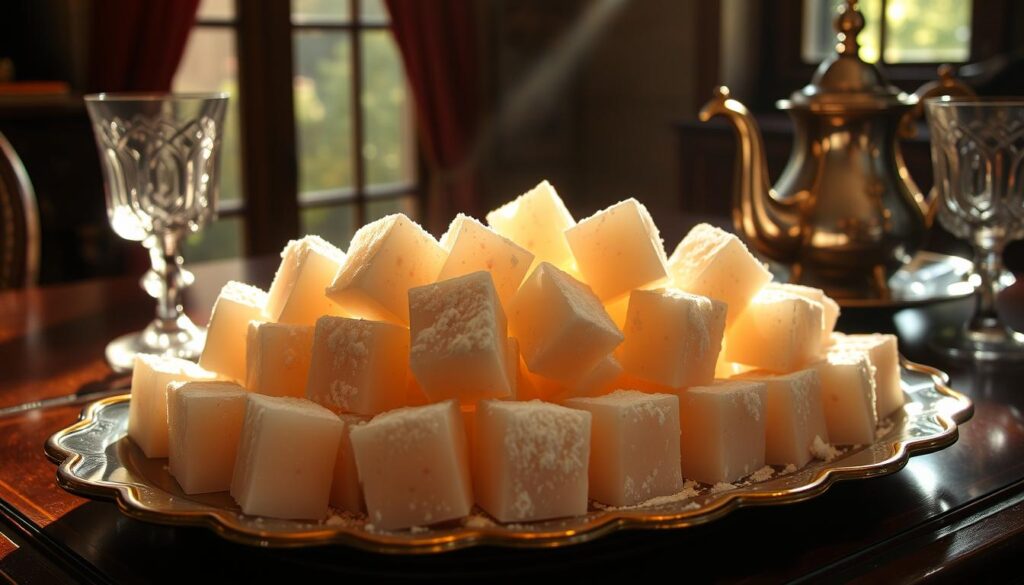
The choice of Turkish Delight as the candy used by the White Witch to tempt Edmund can be seen as a reflection of Lewis’s wartime experiences. For more insights into the historical context and the significance of Turkish Delight in ‘The Lion, the Witch and the Wardrobe,’ visit Historical Foods.
Traditional vs. Commercial Turkish Delight
The allure of Turkish Delight is undeniable, yet the difference between traditional lokum and its commercial counterparts is significant. For centuries, lokum has been a beloved treat in Turkey, perfected by candymakers without the influence of mass production. However, the commercialization of Turkish Delight, especially after its feature in C.S. Lewis’s The Chronicles of Narnia and subsequent film adaptations, has led to a proliferation of inferior products.
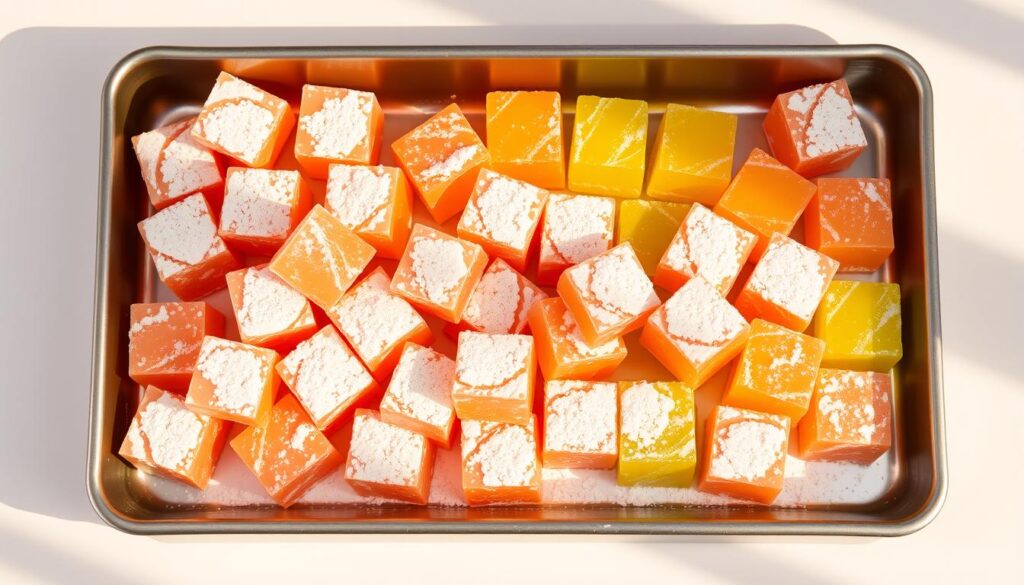
Authentic Lokum vs. Mass-Produced Versions
Authentic lokum from Turkey is known for its delicate texture and rich flavor profile, which is often lacking in mass-produced versions. The ingredients and preparation methods used in traditional lokum contribute to its superior quality. In contrast, commercial Turkish Delight often relies on preservatives and artificial flavorings, resulting in a less satisfying experience for consumers.
The Expectation vs. Reality Phenomenon
Many fans of The Chronicles of Narnia are disappointed when they try commercial Turkish Delight, as it fails to live up to the enchanting description in C.S. Lewis’s novel. The expectation created by Lewis’s vivid portrayal of the White Witch’s enchanted treat is starkly contrasted with the reality of mass-produced Turkish Delight, leading to a cultural phenomenon where people express their disappointment online.
Understanding the differences between authentic lokum and commercial Turkish Delight can help appreciate why Edmund found it so irresistible in The Chronicles of Narnia. By experiencing the real lokum, fans can gain a deeper appreciation for the cultural context and the sensory details that made it a pivotal element in the story.
Making Your Own Magical Turkish Delight

Creating your own Turkish Delight at home is a rewarding experience that combines traditional techniques with personal touches. To embark on this culinary adventure, you’ll need to understand the essential ingredients and equipment required for the task.
Essential Ingredients and Equipment
The foundation of authentic Turkish Delight lies in its simple yet precise ingredients. You’ll need sugar and water to create a syrupy base, while a cornstarch slurry serves to thicken and solidify the delights. Flavorings such as rosewater extract can be used, though they’re optional, allowing you to experiment with different tastes. Additionally, powdered sugar is necessary for dredging the finished delights, and citric acid adds a touch of tartness to balance the sweetness.
As for equipment, a candy thermometer is crucial for achieving the correct sugar temperature—the soft ball stage at 250°F. A heavy-bottomed pot is also essential for maintaining consistent heat distribution during the cooking process, preventing the mixture from burning or developing hot spots.
Preparation Before Cooking
Before you begin cooking, preparation is key. Measure out your sugar, water, and cornstarch accurately, as the ratio between these ingredients is critical to the texture and consistency of your Turkish Delight. Preparing the cornstarch slurry requires care to avoid lumps, ensuring it incorporates smoothly into the sugar syrup.
Understanding the science behind the interaction between sugar and cornstarch is also vital. The precise measurements and temperatures are not arbitrary; they’re the result of the chemical properties of these ingredients. By controlling these factors, you can achieve the desired texture and consistency in your homemade Turkish Delight.
Step-by-Step Turkish Delight Recipe
In this step-by-step guide, we’ll show you how to make authentic Turkish Delight, just like the ones found in Narnia. Making Turkish Delight is a multi-step process that requires attention to detail and patience, but the end result is well worth the effort.
Creating the Sugar Syrup Base
Start by grabbing a heavy-bottomed pot, the kind that won’t scorch your dreams of perfect Turkish Delights. Combine sugar, citric acid, and water in the pot and whisk until the sugar is fully dissolved. Let it simmer, but resist the urge to stir—it’s all about patience here. You’re aiming for 250°F, so grab that candy thermometer and keep an eye on it. The sugar syrup base is crucial for the texture and consistency of your Lokum.
Mixing the Cornstarch Slurry
While the syrup is doing its thing, let’s talk slurry. In a jar, combine cornstarch and water. Seal it up and shake like you’re doing a workout challenge. The goal is a cloudy, well-mixed concoction. This cornstarch slurry will help thicken your Turkish Delight to the perfect consistency.
Cooking and Setting the Lokum
Slowly pour your cornstarch slurry into the bubbling syrup while whisking non-stop. Expect a little drama here—it might bubble and splatter a bit. Keep your cool and keep whisking. Your mixture will start to thicken into a gel, like a potion in progress. Every 8-10 minutes, give your Lokum a good stir to keep it from sticking to the pot. You’re looking for a medium-light amber shade—this should take about 45-60 minutes. Once you’ve hit that lovely golden stage, take the pot off the heat. Stir in your food coloring and extract of choice.
Get your prepared dish ready—a 9×9 inch pan lined with parchment and lightly oiled. Pour in the Lokum and spread it evenly. Now, patience is key again: let it set at room temperature for 5-10 hours. Do not rush to the fridge! The Lokum sets best at room temperature. After waiting, the fun part begins. Flip the Lokum onto a cornstarch-dusted cutting board, peel off the parchment, and dust the top with more cornstarch. Cut into bite-sized pieces. Over in a separate dish filled with powdered sugar, dredge each piece until they’re coated like snowy Narnia.
| Step | Time | Temperature |
|---|---|---|
| Creating Sugar Syrup Base | Until 250°F is reached | High heat |
| Mixing Cornstarch Slurry | 5 minutes | Room temperature |
| Cooking and Setting Lokum | 45-60 minutes | Medium heat |
| Setting Lokum | 5-10 hours | Room temperature |
Bringing Narnia’s Magic to Your Kitchen
As we conclude our journey into the world of Turkish Delight, we bring a taste of Narnia’s magic to your kitchen. To keep your homemade Turkish Delight fresh, store the candy pieces in an airtight container filled with a mixture of powdered sugar and cornstarch in a 2:1 ratio. Enjoy your delight within 72 hours for the best experience. Making this treat is a journey that connects you to both literary history and culinary tradition. For more on the story behind this enchanting candy from Narnia, explore our related content.
By crafting these magical sweets from scratch, you’re not just making a treat; you’re experiencing a piece of history. Whether you’re looking to recreate Edmund’s temptation or simply seeking a unique sweet delight, this homemade Turkish Delight is sure to transport you to a world of wonder.
